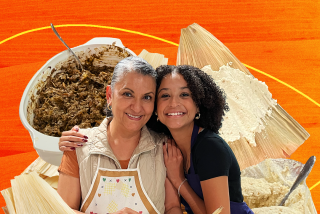Op-Ed: A Southern California Thanksgiving
Who told the story first? The story of Native Americans bringing food to the Pilgrims, who were hungry, weary, wary neighbors in Plymouth — roasted fowl, gourds, corn and fish?
The traditional Thanksgiving turkeys of my Southern California childhood, awkwardly big birds on my mother’s Formica counter, frightened my siblings and me. We were meant to pull out the frozen neck and guts and heart, to watch as women put stuffing into the most undignified cavities, and hours later to watch as men wielded huge shivering electric knives to slice off the legs.
Oh, California, here we are all natives or pilgrims, constantly moving and starting anew, and the bounty lasts all year.
As an adult, I eventually abandoned the turkey, yams and cranberries. One Thanksgiving we had 12 people with very little in common but politeness and nowhere else to go, and we served crab legs and shrimp enchiladas. Another Thanksgiving I hosted a backyard potluck with friends of a daughter who wasn’t even home, along with very small children who had no interest in the food but wanted to play with my chickens — which were not on the menu. It remains one of my favorite Thanksgivings: Live birds. Not dead. Salad and enchiladas and ice cream.
The rigid menu doesn’t matter, and neither does the day — that arbitrary fourth Thursday in November. But the spirit does: the spirit of thanks, of course, as well as the somewhat less noted spirit of giving. This is Southern California. We harvest all year; the cornucopia is not fall-oriented. We should give all year too.
I have lived in my former orange-grove farmhouse since 1988, and the generosity of the neighbors native to my street began immediately and continues now. Mine is the kind of neighborhood where the old concept of the Welcome Wagon was unofficial but strictly observed in the past, and we brought brownies or cookies to new residents. That doesn’t happen quite so automatically anymore, but many of us are still old-fashioned.
Salma, whose last name we never learned, was called the Fig Lady for 10 years by my very small daughters. A native of Lebanon, she told me fragments of stories in her soft, fragmented English, of her country, the violence and what she missed. She saw the two fig trees in my backyard, Brown Turkey and Mission, and asked to harvest them, tears in her eyes. Of course I said yes. For years she brought us foil trays of homemade baklava and what we called the Fig Lady’s Parsley Salad. (We had no idea what tabbouleh was then.)
Maria was born on a tiny farm in an area of the Philippines so rural she told me porch stories of neighbors turning at night into flying animals that could spirit one away. From across the street she brought the best adobo I have ever tasted, the chicken swimming in heavenly scented brown sauce, and lumpia, which I could attempt to replicate but would never come out like hers. I brought her fresh eggs, cherry tomatoes, homegrown squash and corn.
Kim and Rafael, natives of Glendora and El Salvador, have lived next door for nine years now. They bring carne asada and grilled shrimp on Sunday afternoons, and amazing ceviche, in return for eggs (thank God for my chickens) and tomatoes and my own specialties: Mexican rice, Scottish shortbread and cream sherry cake. Rafael climbs the decades-old avocado tree, which gives not one but three harvests of smooth-green-skinned Fuertes every year.
I take avocados to Bryan and Sari, natives of Arkansas and Uganda, who moved to the neighborhood two years ago and who bring their goat-cheese and roasted-cherry ice cream, which is so rich and singular any restaurant would be lucky to have the recipe. I take avocados to Rachel, native of Seattle, down the block, who brings guavas so sweet they perfume the entire house, confusing the dog to no end, and I deliver guavas back to Rafael, who says they remind him of his boyhood.
My apricot tree is 80 years old and barely hanging on, but the old-fashioned delicate fruit is dizzyingly sweet and rich, and intoxicating when Bryan and Sari give their daughter Kai her first taste; nothing like what you can get in a market. I take apricots to everyone in June; Bryan and Sari bring pistachio ice cream in November; and Gurdon and Faye Merchant, both natives of Riverside, bring bags of the sweetest Washington navel oranges in January.
I never look at a fig tree without remembering Salma, her tiny bustle of a body barreling into my backyard, her small hands so worn and fingers crooked from arthritis, reaching into the branches with me, my own girls watching in awe as she bent and whispered, “My country, my country.”
Oh, California, here we are all natives or pilgrims, constantly moving and starting anew, and the bounty lasts all year.
Susan Straight has published 10 novels. She is finishing a novel set on Prince Edward Island and a story collection set around the Golden State Freeway.
Follow the Opinion section on Twitter @latimesopinion and Facebook
More to Read
A cure for the common opinion
Get thought-provoking perspectives with our weekly newsletter.
You may occasionally receive promotional content from the Los Angeles Times.







